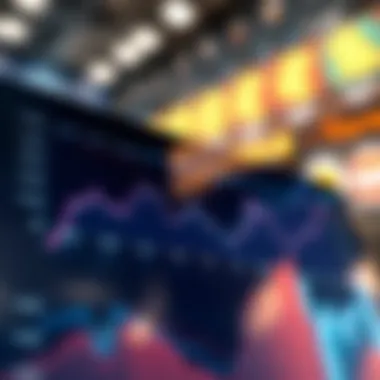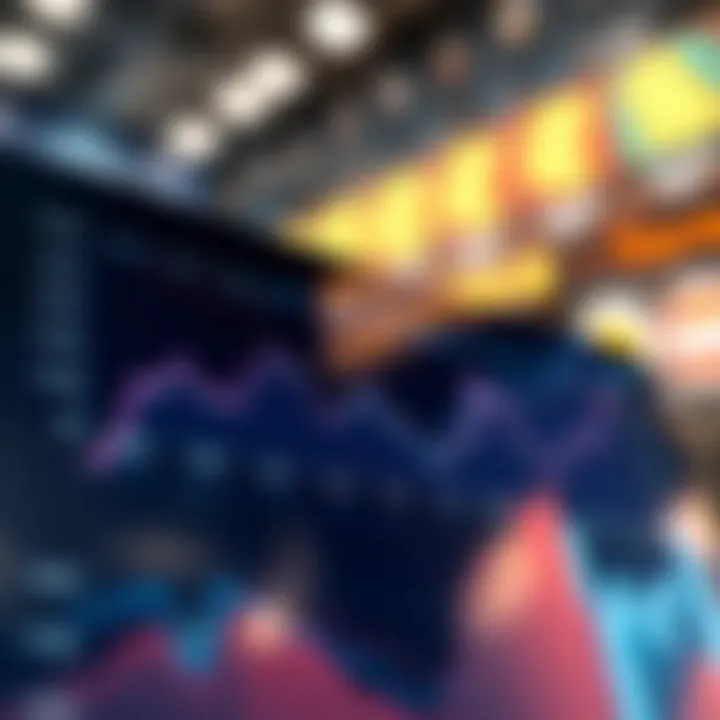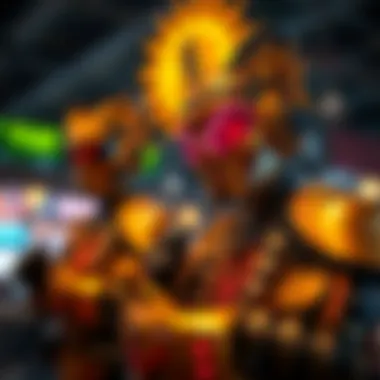Understanding NFT Sales: Insights into Market Dynamics


Intro
The digital realm has ushered in a new frontier of art and commerce, characterized by non-fungible tokens, or NFTs. This digital phenomenon encompasses a wide array of assets, transforming the way creators, collectors, and even investors perceive value. Understanding how NFT sales operate is crucial in navigating this intricate landscape.
The objective of embarking on this exploration is to unlock the complexities behind NFT transactions, market mechanics, and the ongoing trends shaping this space. For those eager to dive headfirst into the world of NFTs, it’s not just about collecting whimsical digital art or virtual real estate; it’s about grasping the underlying factors that drive success in this niche marketplace.
In the following sections, we will unravel the latest trends in cryptocurrency that influence NFT sales, dissect the economic indicators at play, and delve into investment strategies that go beyond mere speculation. There remains a level of uncertainty clinging to the regulatory frameworks governing this domain, and we will examine how these developments shape user experiences and market stability.
Prelude to NFT Sales
As we navigate the complex waters of the cryptocurrency realm, it's vital to shed light on the growing phenomenon of Non-Fungible Tokens (NFTs). The introduction of NFT sales marks not just a shift in the market but also a transformation in how we perceive ownership and value in the digital world.
NFTs represent unique digital assets, distinct from the interchangeable nature of cryptocurrencies like Bitcoin. This personalization creates a new layer of significance, as each token can encapsulate ownership of varying digital items—from art and music to virtual real estate. As interest surges, understanding NFT sales becomes crucial for anyone involved in or affected by digital commerce, be it investors, traders, or tech enthusiasts.
Defining NFTs
To grasp the essence of NFT sales, we must first define what NFTs actually are. Simply put, NFTs are digital certificates of ownership that authenticate the uniqueness of an asset through blockchain technology. Unlike traditional cryptocurrencies, which are fungible and can be exchanged with one another, NFTs possess their own distinct value and identity. This uniqueness is what drives their allure in a market increasingly driven by digital innovation.
Not limited to art alone, NFTs can represent ownership of various forms of digital media. Think of them as collectibles in the digital age; they can include photos, videos, music tracks, domain names, and even tweets. By embedding metadata within the blockchain, each NFT acts as a verifiable record of ownership, making it nearly impossible to counterfeit.
In summary, NFTs take the concept of genuine ownership and place it neatly in a digital framework, presenting a myriad of opportunities for creators and consumers alike.
The Rise of NFTs
The journey of NFTs is not just a tech trend; it's a cultural phenomenon that has taken the world by storm. Over the past few years, the landscape has shifted remarkably. The first NFTs made their debut as simple digital art, but now they have expanded into varied domains such as gaming assets and virtual merchandise.
From the first recognized NFT, CryptoKitties, back in 2017, which allowed users to buy, sell, and breed digital cats, the NFT marketplace has exploded. The mainstream breakthrough came to light when high-profile sales—like Beeple's digital artwork auctioned for $69 million—captured global attention, leading to both bordering fascination and skepticism.
Several factors contributed to the meteoric rise of NFTs, including:
- Widespread Adoption of Blockchain Technology: As more people become familiar with blockchain’s potential, the concept of NFTs becomes more accessible.
- Cultural Shifts in Entertainment and Art: Artists and creators are increasingly utilizing NFTs as a new canvas for expressing their work and connecting with their audience directly.
- Investors Looking for Alternatives: In uncertain financial times, NFTs offer a way for investors to diversify portfolios, with some viewing high-quality NFTs as digital assets set to appreciate in value.
Navigating the current NFT sales landscape requires an understanding of not just technology but also of the emotional and cultural currents that shape this emerging marketplace.
Mechanisms of NFT Sales
Understanding the mechanisms behind NFT sales is crucial for anyone looking to navigate this emerging digital marketplace. The way NFTs are bought and sold doesn't just dictate the flow of assets; it shapes the entire experience for both creators and collectors. In this section, we will delve into the core components that drive NFT transactions and the implications of these mechanisms on the market.
NFT Marketplaces
NFT marketplaces are the lifeblood of NFT sales. These platforms serve as digital galleries where artists and collectors can come together, showcasing their digital assets and facilitating transactions. Some of the most popular marketplaces include OpenSea, Rarible, and Foundation. Each has its own approach and community, fostering significant diversity in NFT offerings.
The significance of reliable marketplaces cannot be understated. A robust, user-friendly platform enhances trust, which is vital in a market often scrutinized for its volatility. Below is a list of key marketplace characteristics:
- User Interface: A clear, intuitive design helps users navigate and find what they are looking for, whether they are artists uploading NFTs or buyers hunting for their next collectible.
- Transaction Fees: Different platforms have varying fee structures which can affect the profitability of sales. It’s crucial for creators to understand these fees to avoid negative surprises.
- Community Engagement: Some marketplaces foster communities that help build brand loyalty and trust, enhancing user retention.
In summary, a marketplace's design, fee structure, and community engagement profoundly impact the sales dynamics of NFTs. The choice of marketplace can ultimately shape the sales trajectory of an NFT significantly.
Bidding vs. Fixed Pricing
One key aspect of NFT sales is the pricing strategy employed: bidding or fixed pricing. Each has its own merits and can cater to different types of buyers.
- Bidding: This method allows buyers to propose their price for an NFT, often leading to competitive pricing and sometimes driving the price far higher than the initial listing. This method can generate excitement and urgency—creating a buzz around the NFT, hence attracting more attention.
- Fixed Pricing: Conversely, fixed pricing gives buyers a clear, upfront amount they need to pay to acquire an NFT. This method may appeal to those looking for certainty in pricing, ensuring they know exactly what they will be paying.
Both methods have their place in the market, and the choice can depend on the seller's objectives and the perceived value of the NFT. Sellers need to carefully consider their approach based on their audience and how they want to position their creations.
Transaction Processes
The transaction process for NFTs can seem complex, but understanding the flow can ease apprehension for new entrants. The steps typically include:
- Wallet Setup: Buyers and sellers need a digital wallet compatible with the blockchain that the NFT is minted on. Ethereum wallets such as MetaMask or Coinbase Wallet are commonly used.
- Minting: For creators, minting is the act of creating the NFT on a blockchain, making it a unique asset.
- Listing: Sellers list their NFTs on a marketplace, either through bidding or fixed price.
- Transaction Confirmation: Upon a successful transaction, both the buyer and seller will receive confirmation, and the ownership will update on the blockchain.
The speed and security of transactions can differ based on the underlying blockchain technology used, which highlights the importance of choosing the right platform for both buying and selling.
In essence, the transaction processes serve as the framework that supports NFT sales. They drive the practicalities of how these digital assets are transferred and provide the foundation for building trust in the NFT economy.


By understanding these mechanisms—marketplaces, pricing strategies, and transaction processes—investors, traders, developers, and tech enthusiasts can better position themselves in the rapidly evolving world of NFT sales.
Market Dynamics
Understanding the mechanics of market dynamics is paramount in grasping the landscape of NFT sales. Market dynamics encompass the various factors that influence the buying and selling behavior of non-fungible tokens, a unique digital asset gaining ground in both collectors’ and investors’ circles. Grasping this concept not only aids participants in navigating the NFT marketplaces but also equips them with the foresight needed to make informed decisions.
Factors Influencing NFT Sales
Several distinct elements play a crucial role in determining the trends and patterns seen in NFT sales. Here are the most significant factors:
- Market Trends: The waves of popularity or sudden declines are shaped by several aspects, such as celebrity endorsements or viral social media trends. A tweet from a well-known figure can catapult an anonymous digital artwork into the spotlight.
- Economic Influences: The broader economic environment invariably affects disposable income levels among buyers. When trends suggest an upcoming economic downturn, consumers may pull back from high-risk investments, including NFTs.
- Technological Advancements: As the infrastructure surrounding blockchain technology develops, it leads to novel applications for NFTs. Emerging smart contract functionalities can boost sales by introducing royalties that benefit creators on secondary sales. This further engages potential buyers who want to support artists while also having a chance at profitability.
- Community Engagement: Active and vibrant communities around NFT projects can have a significant sway over sales. Strong engagement, like participatory events or collaborations with other projects, fosters a sense of ownership and excitement among buyers, leading to increased demand.
In essence, being aware of these factors allows investors and creators to strategize their approaches effectively. As the market continues its evolution, noting how these influences shift will be key.
Understanding Demand and Scarcity
A core principle steering the NFT market is the interplay between demand and scarcity. Much like traditional art markets, the value ascribed to an NFT often hinges on its perceived uniqueness.
Demand can be driven by emotional connections, perceived value, and, at times, sheer novelty. Limited edition drops or features touted as "one-of-a-kind" can stoke the flames of desirability. NFT collectors are often on the lookout for pieces that resonate personally or hold cultural significance. Conversely, the scarcity aspect reinforces that exclusivity. When an NFT is tied to an established brand or artist, it becomes not just a product but a status symbol. Functioning under this model encourages a collector’s mindset, where the rarity of an item amplifies its allure.
"Scarcity is a powerful driver. If you think something is rare, you're likely to want it more."
The factors of demand and scarcity weave a complex tapestry, influencing each other in the NFT marketplace. A sudden increase in demand, if not met with sufficient scarcity, can dilute value, leading to what is often referred to as the "bubble" effect. On the flipside, maintaining scarcity can lead to inflated prices, creating potential pitfalls for both creators and collectors. A careful balance, hence, is necessary for fostering a stable market.
NFT Genres and Their Sales
The landscape of NFT sales is rich and diverse, shaped by various genres that cater to different interests and markets. Understanding these genres provides critical insights into the potential returns for investors and the avenues for creators to monetize their work. Trading in NFTs isn't just a financial decision; it is also about tapping into cultural trends and personal passions. With the NFT market evolving rapidly, grasping the nuances of each genre is vital for anyone looking to dive into this domain.
Art and Collectibles
Art has long been a vehicle for expression, and with the advent of NFTs, creators are now able to sell their digital art securely on blockchain platforms. The transition from traditional galleries to online marketplaces has democratized access for artists, allowing them to showcase their work to a global audience. Successful art pieces often hinge on emotional resonance and storytelling. The use of platforms like OpenSea or Rarible allows artists to create, sell, and profit directly from their creations without the need for intermediaries.
Considerations for these artists include:
- Ownership and Provenance: Blockchain technology guarantees authenticity and ownership, reducing the risk of counterfeits.
- Royalties: Many NFTs incorporate royalty features, enabling artists to earn a percentage of future sales, thus providing a continuous income stream.
However, the art market can be volatile. What captivates one audience may fall flat with another, making it crucial for artists to stay ahead of trends and engage with their community.
Gaming and Virtual Assets
The gaming sector has embraced the concept of NFTs with open arms, blurring the lines between play and investment. In-game assets, such as skins, weapons, and characters, can be bought, sold, or traded as NFTs, allowing gamers to truly own their virtual items. This ownership can lead to significant financial benefits, as rare items can appreciate in value over time.
Some key elements to note:
- Interoperability: NFTs can bridge different games and platforms, allowing users to transport their assets across virtual ecosystems, thus increasing their utility.
- Play-to-Earn Models: Gamers can earn real-world value through gameplay, a model gaining traction in many new titles.
Nevertheless, investors should be cautious. The popularity of a game may wax and wane, affecting asset values. A wealth of speculative ventures exists, making it essential to approach with a discerning eye.
Music and Media
NFTs have opened new avenues for musicians and content creators. Artists can tokenize their music, granting fans exclusive access to unreleased tracks or personal experiences like virtual meet-and-greets. This movement not only allows creators to earn directly from their fan base but also fosters a deeper emotional connection.
Aspects to consider in this genre include:
- Direct Patronage: Fans are more than just consumers; they can become patrons, funding artists directly and receiving perks in return.
- Limited Editions: Artists can create scarcity around their work, offering exclusive drops that entice collectors and generate buzz.
Despite the opportunities, the music industry faces its own challenges. In the midst of rapid growth, navigating copyright issues and ensuring royalties are honored can be complex. It's crucial for creators to engage with legal frameworks surrounding their work.
"In the world of NFTs, understanding the genre and its appeal can make all the difference between a mere transaction and a transformative experience."
In summary, each genre of NFTs presents unique opportunities and challenges. As the market continues to grow and evolve, staying informed and adaptable is key for both creators and collectors.
For further insights and discussions on NFTs, visit Wikipedia, Britannica, or check community perspectives on platforms like Reddit.
Trends in NFT Sales
The realm of NFTs is ever-evolving, and keeping an eye on emerging trends is crucial for anyone engaged in this space, be it investors, traders, or developers. Understanding these trends offers various insights into what drives the market and how one can navigate through its complexities. This segment outlines significant trends currently shaping NFT sales, focusing particularly on the role of technology and the impact of social media.


Emerging Technologies
In the rapidly shifting landscape of NFTs, technology plays a pivotal role in shaping how these digital assets are designed, sold, and traded. Blockchain innovations are at the heart of these changes, encompassing advancements in scalability, user experience, and security.
- Layer 2 Solutions: As transaction volumes surge, many platforms are turning to Layer 2 solutions like Optimistic Rollups and zk-Rollups. They allow for faster transaction processing while reducing costs, making NFT sales more accessible to a wider audience.
- Cross-Chain Support: The integration of cross-chain functionalities is gaining traction. This technology allows NFTs to be transferred and traded across different blockchain networks, increasing liquidity and market reach.
- Smart Contracts: Enhanced smart contract capabilities are paving the way for tailored solutions that meet specific buyer and seller needs. The introduction of customizable and automated smart contracts can revolutionize the NFT sales process, providing greater efficiency and security.
Adoption of these technologies not only boosts the usability of NFTs but also attracts diverse participants from the tech community eager to explore their potential. It speaks volumes about how innovation will drive NFT sales forward, keeping the ecosystem vibrant and profitable.
Influence of Social Media
Social media platforms have become the lifeblood of the NFT market, serving as digital galleries where creators showcase their work and engage with potential buyers. Their role extends beyond mere advertisement; they have crafted communities that foster interaction among users and creators alike.
- Platform-Specific Trends: Platforms like Twitter and Discord have emerged as hubs for NFT discussions. Users frequently share insights, drops, and upcoming launches, faciliating a breeding ground for ideas and collaborations.
- Celebrity Involvement: Social media has also seen a surge in celebrity endorsements and involvement in NFT projects. Their participation often propels certain projects into the spotlight, creating buzz and urging their fans to engage.
- Community Building: Successful NFT projects are often those that prioritize community engagement over the mere act of selling. Active communities on social media help in retaining value and fostering loyalty among collectors, making them more likely to support their favorite creators long-term.
"Community drives the NFT market—people buy into the story, the artists, and the engagement, not just the digital token itself."
Ultimately, the symbiotic relationship between NFTs and social media not only augments visibility but also influences buying behaviors significantly, defining a new landscape for digital asset sales.
Understanding trends like these is indispensable for all stakeholders in the NFT space as they clarify the potential avenues for growth, engagement, and profitability. For further exploration of NFTs and their implications, consider diving deeper into sources such as Britannica or community discussions on Reddit.
Legal Considerations in NFT Sales
Navigating the landscape of NFT sales demands more than just an appreciation of technology and creativity; it also requires a keen understanding of the legal environment that surrounds these new digital assets. This section delves into the critical legal considerations entwined with NFT transactions, shedding light on intellectual property rights and regulatory issues that both creators and collectors must navigate.
Intellectual Property Rights
When we talk about NFTs, we're not just discussing digital tokens. At their core, they are representations of various intellectual property rights. The essence of an NFT often ties back to ownership claims over digital works like art, music, or any other creative content. This intersection of technology and law raises several important questions.
- Ownership vs. Copyright: Owning an NFT does not automatically bestow copyright over the underlying work. Creators retain their copyrights unless explicitly transferred. Buyers must be aware that purchasing an NFT might only grant them the right to display it or use it in a certain capacity, rather than the works themselves.
- Licensing Agreements: Clarity in licensing agreements is paramount. Creators should define what rights are attached to their NFTs when selling. If a buyer misunderstands what they can or cannot do with an NFT, legal disputes may arise.
- Derivative Works: Many digital creators contribute to a culture of remixing and adaptation. Ownership of an NFT does not automatically grant rights for creating derivative works unless explicitly stated.
These discussions not only influence the value of the NFTs but also indicate the necessity for clear communication between creators and buyers in order to limit potential conflicts.
Regulatory Landscape
As the NFT space gains traction, so too does the attention of regulatory bodies. The evolution of laws surrounding NFTs is unfolding at a fast pace, and understanding this regulatory landscape is crucial for any stakeholder in the space. Here’s what one should keep an eye on:
- Securities Law: Depending on how NFTs are marketed or sold, they could inadvertently fall under securities regulations. If an NFT is deemed an investment contract, it needs to comply with existing securities laws, which can vary significantly between jurisdictions.
- Tax Implications: Tax treatment of NFTs, both for buyers and sellers, is still murky. It's critical for participants to familiarize themselves with local tax obligations, especially regarding capital gains and potential reporting requirements.
- Consumer Protection Laws: As the NFT market expands, consumer protection regulations might come into play, addressing issues of fraud, misrepresentation, and other malpractices prevalent in fast-moving markets.
Understanding these regulations can help guide creators and collectors in making informed decisions about their digital transactions and protecting themselves from unforeseen legal issues.
As the NFT marketplace evolves, so does the complexity of its regulatory environment. Stakeholders must remain vigilant to avoid liabilities.
Ultimately, having a comprehensive understanding of the legal intricacies governing NFTs not only enhances the collector's experience but safeguards the creators' rights and the integrity of this burgeoning market.
Be it navigating intellectual property rights or understanding the regulatory landscape, a more informed approach leads to a healthier artistic ecosystem.
The Role of Community in NFT Sales
In the rapidly evolving digital landscape, the community surrounding NFT sales plays a foundational role in their success or failure. Simply put, an engaged and motivated community can be the lifeblood of NFT projects. Creators, collectors, and investors alike find that strong community ties foster an environment that encourages participation, investment, and growth. This section will delve into the crucial elements that contribute to such a community and how they impact NFT sales.
Building a Supportive Ecosystem
The cohesion of a community is central to the NFT ecosystem. When creators establish a supportive ecosystem, it not only attracts collectors but also keeps them engaged over time. This involves several key elements:
- Open Communication: Transparency is vital. Creators should foster an environment where feedback is welcomed and responded to. Platforms like Discord and Telegram offer spaces for real-time dialogue, making it easier for creators to connect with their audiences.
- Resource Sharing: Knowledge is power in the NFT space. Those in the community can benefit from shared insights on marketing strategies, technical know-how, and sales approaches. Group chats or forums can become treasure troves of information.
- Collaborative Projects: Teaming up with other creators or influencers boosts visibility and creates buzz. Joint ventures can lead to innovative NFT drops that pique the interest of potential buyers.
These elements forge a nurturing environment where everyone feels valued. The sense of belonging can enhance loyalty, resulting in consistent support and advocacy from collectors and fans.
Engagement and Retention Strategies
Keeping a community engaged is no walk in the park, especially in an era where trends shift faster than one can blink. However, there are effective strategies that work well to retain interest:
- Regular Updates: Regularly informing the community about upcoming projects or changes maintains interest and strengthens connections. An informative newsletter may be a straightforward yet powerful tool for this.
- Interactive Experiences: Hosting live Q&A sessions, virtual galleries, or exclusive community events can foster greater ties. These experiences engage participants directly and help solidify their connection to both the creator and the NFT.
- Incentive Programs: Introducing rewards for loyal supporters, such as exclusive access to new drops or unique pieces, can spark a sense of investment in the community. This financial incentive, alongside emotional engagement, can significantly enhance member retention.
Thus, a well-kept community can act as a powerful marketing engine. As people feel more connected, they are likely to share their experiences, garnering interest from others who may not have been aware of the project before.
"A community doesn’t just support an NFT; it amplifies its impact across the digital landscape."


Implications for Creators and Collectors
The world of NFTs presents unique implications for both creators and collectors that are worth exploring in detail. As this market expands, understanding these implications can assist in maximizing opportunities while mitigating potential pitfalls. Each player's role in the ecosystem—from artists to buyers—shapes the narrative of NFT sales; highlighting the benefits and considerations ensures both parties are well-prepared for the journey ahead.
Monetization Opportunities
NFTs provide creators with avenues for monetization that weren’t available before. The explosion of digital art, music, and other media into tradable digital assets has reshaped how selling and owning art functions. Here are some significant monetization opportunities:
- Direct Sales to Collectors: Artists can sell their work directly to consumers through platforms like OpenSea or Rarible, cutting out middlemen who typically take significant commissions. This model allows creators to set their own prices based on their perceived value in the market.
- Royalties on Resales: One of the standout features of NFTs is the ability for creators to earn royalties on secondary sales. This means that every time an NFT is resold, the originator can receive a percentage of the sale. This can create a continuous revenue stream and incentivizes artists to produce higher-quality work.
- Crowdfunding Projects: Artists can use NFTs to fund new projects by selling tokens that represent various tiers of involvement, such as exclusive content or early access to new releases. This not only raises funds but also builds an engaged community around their work.
- Collaborations and Partnerships: Many artists are partnering with brands or other creators to produce unique NFT collections, mutually benefiting from shared audiences and expanding their market reach. By leveraging each other's strengths, they create compelling works that can command a higher price.
As such, the potential for revenue generation in the NFT space is substantial, opening doors not only for visual artists but also for musicians, writers, and other digital creators.
Risks and Challenges
While opportunities abound, there are also inherent risks and challenges that both creators and collectors must navigate in the NFT landscape. Understanding these can be crucial to sustaining success and avoiding costly missteps:
- Market Volatility: NFT prices can swing dramatically, influenced by trends, celebrity endorsements, or even social media buzz. This volatility can leave collectors and artists alike uncertain about the long-term value of their assets. It’s vital for participants to stay informed about market trends and avoid impulsive purchases based solely on hype.
- Intellectual Property Issues: Creators may not always understand the implications of copyright when minting NFTs. There are instances where original works have been tokenized without the artist's consent, leading to legal disputes. Creators should educate themselves about intellectual property rights and consider registering their work to protect it.
- Environmental Concerns: The environmental impact of blockchain technology, particularly those relying on proof-of-work systems like Ethereum, has come under scrutiny. As discussions about sustainability grow, creators and collectors must weigh the ecological ramifications of their decisions, potentially seeking platforms that use more eco-friendly practices.
- Scams and Fraud: Given the rapid development and hype surrounding NFTs, the sector has attracted unscrupulous actors. Creators are at risk of losing their work to theft, while collectors may fall prey to counterfeit NFTs. Conducting thorough research and due diligence is paramount to ensure that both buyers and sellers are engaging in legitimate transactions.
In sum, while NFTs empower creators to monetize their work in thrilling new ways, they also come with a slew of risks that need careful consideration. Creators and collectors alike must navigate this evolving landscape with caution, balancing innovation with prudence.
For further insights, refer to sources like Wikipedia on NFTs, Britannica, and discussions on Reddit. Engagement in community forums can also provide useful perspectives from others in the NFT space.
Future Outlook on NFT Sales
The future of NFT sales holds a significant place in today's fast-evolving digital economy. As the landscape continues to change, grasping the potential developments within this market is vital for creators, collectors, and investors alike. The impending transformations will not only influence how NFTs are bought and sold, but they will also reshape the broader narrative of digital ownership and the underlying technologies that support these transactions.
Anticipating the future helps stakeholders make informed decisions, preparing them to navigate the challenges and opportunities that lie ahead. From technological advancements to shifts in consumer behavior, a proactive approach to understanding these factors can pave the way for success in an increasingly digitized world.
Predictions and Forecasts
Several forecasts emerge as we look ahead to the evolving realm of NFT sales. Notably:
- Wider Adoption: The likelihood of NFTs gaining mainstream traction is high. Traditional industries are beginning to explore NFTs' potential, from real estate to music to ticketing. Analysts predict a crossing of the chasm where everyday users will engage with NFTs beyond just trendy digital art.
- Enhanced Interoperability: As blockchain technology matures, we might witness enhanced interoperability between various platforms. This means NFTs designed on one blockchain could easily move or function on another, similar to how emails can be exchanged across different providers. This would increase the liquidity of NFTs and facilitate more fluid transactions.
- Integration with Augmented Reality (AR): There's a growing trend to merge NFTs with AR. Imagine viewing holistic art pieces that exist in virtual spaces, adding layers of experience to digital ownership. With the tech behind AR improving, this prediction appears promising.
- Security Innovations: Security concerns surrounding NFT transactions may lead to advancements in protocols. Enhanced security measures could significantly minimize fraud, reassuring buyers and consequently attracting more investors.
Sustainability Considerations
Sustainability has become a buzzword in many industries, and NFTs are no exception. As we project into the future, various sustainability factors demand attention:
- Energy Consumption: Much debate has arisen regarding the carbon footprint of blockchain technology, especially proof-of-work systems. Moving forward, there is a call for NFTs miners and platforms to adopt more energy-efficient systems to lower their environmental impact. Transitioning to proof-of-stake or other eco-friendlier algorithms may be a critical step in ensuring long-term viability.
- Digital Waste: There’s an underlying risk with NFTs becoming obsolete or turning into digital waste. Creators and marketplaces must consider how to de-list or recycle NFTs that have lost value, thereby establishing a more circular economy.
- Consumer Awareness: The growing eco-conscious consumer base will factor into NFT purchases. Buyers are more likely to support platforms that demonstrate a commitment to sustainable practices, such as carbon offsets or community projects that promote environmental responsibility.
"In a world increasingly concerned with sustainability, NFT creators and collectors must reckon with the ecological implications of their digital assets."
Overall, a forward-looking perspective about NFT sales involves comprehending trends, embracing technology, and prioritizing sustainability. For investors and creators, keeping a pulse on these dynamics is crucial for tapping into the vast potential of NFTs as they carve out spaces in our digital and physical realities.
Finale
The conclusion of this article serves as a vital summarization of the key elements discussed throughout the exploration of NFT sales. Its importance lies in encapsulating the journey through which the reader has navigated—from defining what NFTs are, examining their market dynamics, and exploring the implications for both creators and investors. The world of NFTs is complex and evolving, making it essential for all stakeholders to grasp its intricacies and potential impacts thoroughly.
In the rapidly shifting landscape of digital assets, understanding these nuances is paramount. Here’s why:
- Clarity on Emerging Trends: By summarizing important insights, readers can better prepare themselves for the changes in the NFT ecosystem. This awareness can inform their decisions, whether they are investors looking to capitalize on upcoming trends or developers aiming to innovate.
- Assessment of Risks: With the volatility of NFT value, a recap helps spot potential pitfalls. Recognizing trends and understanding market dynamics can avoid costly mistakes.
- Strategic Positioning: For creators and businesses, knowing key takeaways enables them to strategize their approach in launching or promoting their NFTs. They can tailor their offerings based on what is currently resonating within the market.
Overall, this section crystallizes the extensive insights shared in this article, allowing readers to comprehend the broader context in which NFT sales operate. It’s this integrated understanding that ultimately empowers them to engage effectively in the NFT space.
Recap of Key Insights
To distill the essence of this discussion, let’s highlight some pivotal insights:
- NFT Definition: NFTs are unique digital assets that are non-interchangeable, representing ownership of specific items or content on the blockchain.
- Market Mechanisms: NFT transactions may occur through various platforms, utilizing fixed pricing or bidding processes to ensure buyers and sellers engage according to their preferences.
- Demand and Scarcity: The NFT market thrives on the principles of demand and scarcity. Limited editions and unique artworks often command higher prices than more common offerings.
- Emerging Technologies: Advancements such as augmented reality and virtual reality are influencing NFT creation and sales, thus elevating user experiences.
- Legal Considerations: Navigating the legal landscape regarding intellectual property rights is essential for both creators and collectors to avoid disputes.
These insights serve as foundational knowledge for anyone involved in the NFT market, fostering a well-rounded understanding of its nuances and prospects.
Final Thoughts
In wrapping up this discussion on NFT sales, it's critical to recognize how the field is shaped not just by technological innovation but also by the broader cultural and economic factors at play. As the market matures, it's likely that we will see a more defined regulatory framework emerge, which could influence how NFTs are bought, sold, and valued.
Investors, traders, and developers should remain eagle-eyed on market trends and legal changes—staying informed is not just beneficial; it’s essential for meaningful participation in this dynamic space. The prospects that NFTs hold are vast, and while risks exist, the potential rewards are just as significant. This necessitates ongoing education and adaptability in strategies, particularly given the rapid advancements and changing consumer perceptions.
The NFT domain offers a captivating blend of technology, artistry, and entrepreneurship, presenting myriad opportunities for both seasoned investors and newcomers. By continuously seeking knowledge and staying attuned to the evolving landscape, everyone can aspire to make the most informed decisions in this exciting digital arena.
"In the world of NFTs, knowledge is your greatest asset."
For further reading and staying updated, you may find useful resources on platforms such as Wikipedia, Britannica, or community discussions on Reddit.















